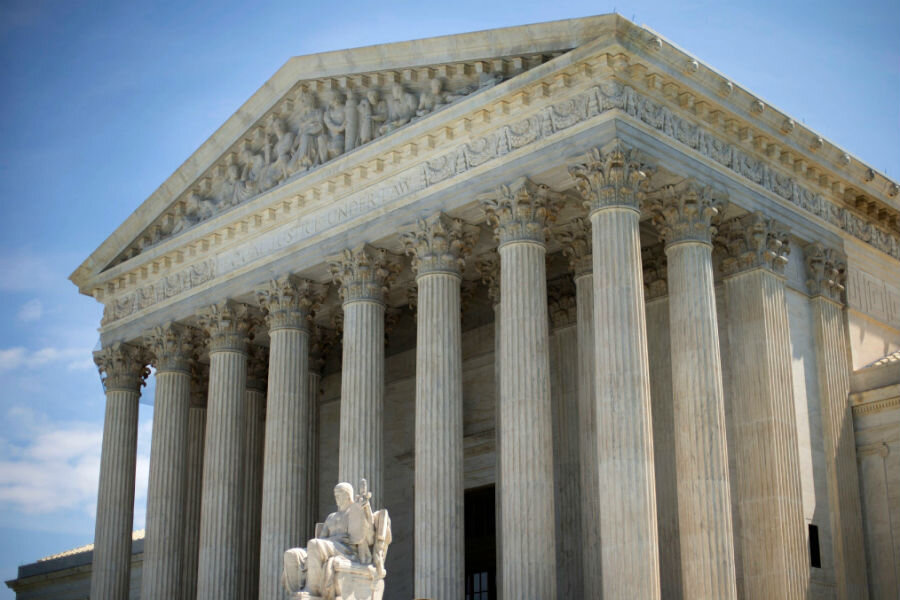Partisan or racial gerrymandering? Supreme Court asked to parse
According to the Constitution and previous court rulings, if a state redraws district lines according to race, it is illegal. But if it is based on partisanship, it is usually still permissible, given the Supreme Court's difficulty defining a legal standard.
But how can officials discern the motives of race or partisanship in redistricting, especially where race often becomes a reliable indicator of how one votes?
Those are the questions that Supreme Court justices grappled with Monday when they heard two separate cases that alleged Virginia and North Carolina, both states with Republican legislatures, purposefully redrew district lines to pack African-American voters into a few districts, thus diluting their overall influence in electing favored candidates.
“Is it politics or is it race?” Justice Elena Kagan asked, according to the Charlotte News & Observer. “If it’s politics, it’s fine; if it’s race, it’s not.”
The states said that they legally drew the borders based on partisanship, not race. Critics, however, say given the current political demographics where minorities tend to vote Democrat, the states were using partisanship as an excuse for covering up their intentions in gerrymandering. A panel of three federal judges agreed, finding evidence of racial gerrymandering earlier this year.
Parsing the nature of partisanship is a tough feat, as the eight-member court recognized in the hearing. Yet a definition may be sorely needed as more lawsuits regarding partisan and racial gerrymandering are brewing around the nation, highlighting how intertwined race and politics have become, as laws originally enacted to protect minority rights have failed to evolve alongside changing political demographics.
“Race and politics are fused in the South increasingly, and because the court has refused or has been unable until now to place partisanship out of bounds [in gerrymandering,] you end up with an odd situation that the court has to determine what is race and politics,” Michael Li, a redistricting expert with the New York University Brennan Center for Justice, tells The Christian Science Monitor. The center filed a brief in support of the N.C. plaintiffs. “Even if you were targeting people politically, you could still have a significant racial impact.”
The case in North Carolina revolves around controversial boundaries drawn around two majority-black congressional districts. The state is accused of packing African-American voters into oddly-shaped districts to diminish their voting strength in other districts. Virginia, on the other hand, was sued for redrawing 12 legislative districts, each with the same fixed minimum percentage of black voters, regardless of the actual demographic breakdown in the areas.
Paul Clement, the lawyer representing the Republican legislatures, argued that in North Carolina, the districts were drawn to comply with the Voting Rights Act and to maximize partisan advantage. Redrawing electoral districts based on political data is a common, legal strategy, he said, as reported by The Los Angeles Times.
Marc Elias, the lawyer for the Democrats, fired back that Republicans were adding unnecessarily large numbers of black voters into a few districts, and that requiring districts to have at least 55 percent of the voting residents be African-American – like Virginia did – is a one size fits all method that moves around voters solely based on the color of their skin.
The Supreme Court justices appeared concerned about the outsize role race played in the two gerrymandering cases. Justice Samuel Alito also noted the requirements states have to follow are very complicated, and wondered if ruling on these cases will invite new litigation every time a boundary is redefined, the Associated Press reported.
“It’s an issue that the court has found complicated,” Mr. Li says. “Map drawers are obligated to comply with the Voting Rights Act to try to ensure racial fairness. At the same time, the court says you can go too far in doing that.”
Since the 1960s, the Voting Rights Act has intended that race be taken into consideration during redistricting to prevent minority votes from being diluted. The act was enacted then in response to how black voters in the past were purposefully spread out to become minorities in districts, thus preventing their favored candidates from gaining enough support.
But over the years, experts note, the stipulations in the act have instead been used to pack black voters into specific districts, concentrating their influence within a limited geographic area.
Some observers have said that by outlawing partisan gerrymandering, the courts wouldn’t have to struggle to identify politics or race as motivating factors. Another solution, practiced by California and Arizona currently, is to establish an independent and nonpartisan commission to be in charge of redrawing districts.
The Supreme Court is expected to issue a ruling on these cases by next June.







